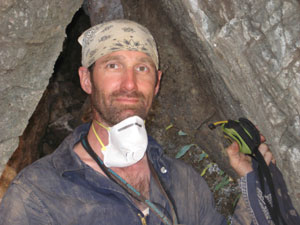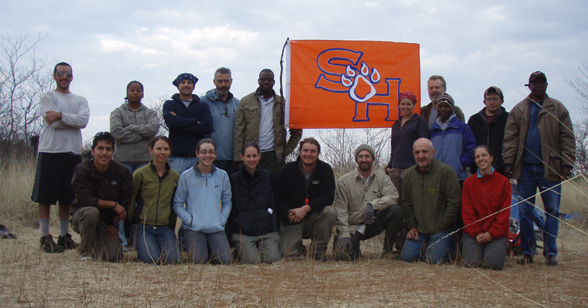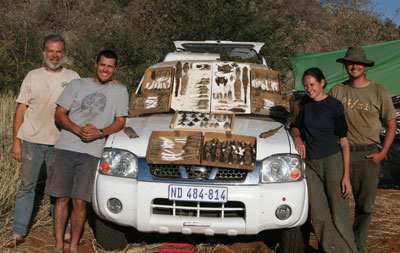Professor's Prehistoric Passion Leads Team To Africa
June 14, 2011
SHSU Media Contact: Amy Barnett
Associate professor of paleobiology Patrick Lewis was featured in the Spring 2011 edition of the Heritage magazine. He and his team are preparing to return to Africa in a few weeks to continue their work. "We are putting in a grant next month that will hopefully keep us going a few more years," Lewis said. Copies of the magazine are available in the Office of Marketing and Communications, in Administration Building Suite 115.
 As a child growing up in Evansville, Ind., Sam Houston State University biology associate professor Patrick Lewis was always fascinated with fossils.
As a child growing up in Evansville, Ind., Sam Houston State University biology associate professor Patrick Lewis was always fascinated with fossils.
“I would sit in my gravel driveway and find hundreds of fossils every summer,” said Lewis. “I was a geeky kid who built dinosaur models and drew pictures of them.”
So it would seem only natural for Lewis to want to pursue a degree in archeology or anthropology. Even though he ended up taking that path in education, it wasn’t his first game plan out of high school.
Lewis had plans to go to medical school after getting his undergraduate degree. But during his third year at Indiana University, he dropped out of college and joined the United States Air Force. He served eight years before finally realizing the career path he wanted to take.
Lewis moved to Texas and attended Texas Tech University, where he received a bachelor’s degree in anthropology, followed by a master’s degree in evolutionary biology. He later got his doctorate in biological anthropology and anatomy at Duke University.
In 2006, Lewis and his wife decided to move back to Texas where she has family. That’s when he came to SHSU to teach, do research and revisit his childhood passion of searching for fossils.
“I was always interested in the past, so I knew I would enjoy doing that,” said Lewis.
Lewis is currently involved in several research projects that cover a variety of locations and periods, but most center on the effects of environmental change on the skeletal and dental morphology of fossil animals.
One such project has taken Lewis and his team of researchers, which includes several SHSU students, to the Koanaka Hills region of the Republic of Botswana, a country in southern Africa.
“There’s a cave there that dates back to the Pleistocene (two million years),” said Lewis. “It has deep layers of fossils that pretty much span the past two million years, and most are of small mammals.
“Small mammals are really good at rebuilding past environments. So we’re interested in how the environment has been changing over the past two million years in terms of global warming and ice ages, and how mammal populations respond to large-scale climate changes.”
Since 2007, Lewis and his team have made three trips to Botswana. Although they’ve gone each time equipped with tools, food, water and a detailed plan of what they need to accomplish, the obstacles they face are countless.
First, they have to fly into South Africa and drive for three days, partly off-road, to get to the cave site.
“Then we have to get down into the cave,” said Lewis. “It is a nasty cave; we have to wriggle down 150 feet before it opens up. It’s full of snakes and bats and there are even leopards living down there. Plus, it’s very hot.”
 |
Lewis's 2009 Botswana team |
After their first visit in 2007, Lewis decided to bring professional cavers with them to make sure they made it in and out of the cave safely.
He contacted Steve Thompson from the SHSU Outdoor Recreation Program, who, along with students, taught Lewis and his team how to climb and repel and helped them get in and out of the cave.
The Botswana military also joined them, focusing on keeping Lewis and his team out of harm’s way, often warning them of nearby elephants and lions. They also supplied researchers with 10,000 liters of water.
“Our first plan was to get fossils and compare them to the modern environment, but we realized we didn’t know about the modern environment because nobody had ever been out there to trap anything,” said Lewis.
Lewis invited SHSU biology professor Monte Thies, who is a modern mammalogist, to go as well. Thies spent his time in Botswana trapping and killing hundreds of reptiles, amphibians and small mammals to create a baseline for the study.
The group made an agreement with the Batswana to share the collection of modern animals. Botswana now has a collection of porcupines, honey badgers, bats, snakes, frogs, lizards, scorpions and approximately 25 different species of small mammals.
Lewis and his fellow researchers will now continue to evaluate the modern collection so they will later be able to compare the climates of today and those of the Pleistocene.
 |
| Some of the items Lewis and his team have collected during their three years of traveling to Botswana, Africa. —Submitted photos |
The next trip will take them to Africa during its summer so trappers can find different animals and plants to study. That will also mean Lewis and his students will be up against more snakes and dangerous temperatures.
“I’m a little worried about it. It is a malarial area and it will be 10 times as hard to get out there because everything will be alive and growing,” Lewis said.
Until then, Lewis has other projects to keep him busy; one is keeping him close to home.
This site was discovered when an amateur collector found several mammoth tusks in a trench near Cypress Creek in the Katy Prairie Conservancy in Katy.
He contacted a professor at Texas A&M University, who contacted Lewis. Together teams from the two universities made a discovery that could change the way scientists view the effects of the last Ice Age on North America.
“We found a molar from a Toxodont,” said Lewis. “Probably not many people have heard of it, but it is a big rhinoceros type of animal that was only known to have lived in South America. So this is the first ever known in North America.”
The groups also recovered fossils from two different species of horse, camels, sloths, mammoths, and proboscideans, which are related to mammoths.
“This site in Katy preserves the height of the last Ice Age. It’s about 50,000 to 60,000 years old we think,” said Lewis.
“Several sites in East Texas date to the end of the last Ice Age, but there’s not any that date to this age when things are at their coldest. We’re talking about a time when the last Ice Age is really getting going. We’re interested in seeing what animals were like then, so we can compare them to the end of the Ice Age.”
Lewis and his team, along with researchers from Texas Tech University, the University of Texas and Texas A&M, plan to return to the Katy site in January to continue digging for new evidence of prehistoric life.
What makes this site even more exciting, according to Lewis, is that it allows many SHSU biology students to get involved in the research.
“It takes a lot of time and money to work in Botswana; it’s dangerous and you can’t include everybody,” said Lewis. “But with this site, when we went down in May, we took the whole lab down. We had 10 Sam students with us.”
While the act of digging up fossils was enough to keep Lewis’s attention as a child, he said he has an entirely different reason for doing it today.
“So much is being driven by climate change. We need to learn how climate changes in the past affected animals and plants at that time so we can better understand what’s going to happen in the future. Then we can learn what we can do to help prevent a real crash in the mammal population.”
- END -
This page maintained by SHSU's Communications Office
Director: TBD
Assistant Director: Julia May
Writer: Jennifer Gauntt
Located in the 115 Administration Building
Telephone: 936.294.1836; Fax: 936.294.1834
Please send comments, corrections, news tips to Today@Sam.edu.

 SamWeb
SamWeb My Sam
My Sam E-mail
E-mail

